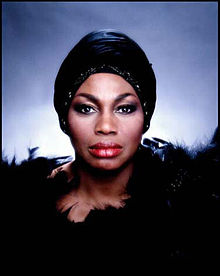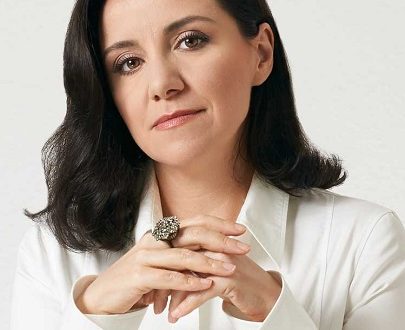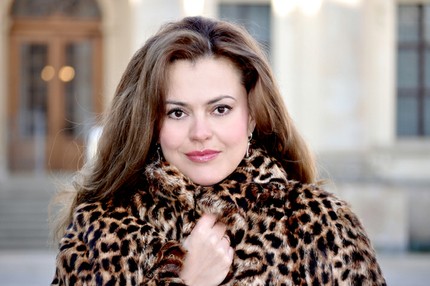
Leontyne Price |
Leontyne Price
When asked if the color of the skin can interfere with the career of an opera performer, Leontina Price answered this way: “As for the admirers, it does not interfere with them. But for me, as a singer, absolutely. On the “fertile” gramophone record, I can record anything. But, to be honest, every appearance on the opera stage brings me excitement and anxiety associated with makeup, acting and so on. As Desdemona or Elizabeth, I feel worse on stage than as Aida. That’s why my “live” repertoire is not as big as I would like it to be. Needless to say, the career of a dark-skinned opera singer is difficult, even if fate did not deprive her of her voice.
Mary Violet Leontina Price was born on February 10, 1927 in the southern United States, in the town of Laurel (Mississippi), in a Negro family of a worker at a sawmill.
Despite the modest income, the parents tried to give their daughter an education, and she, unlike many of her peers, was able to graduate from college in Wilferforce and take several music lessons. Further, the path would have been closed to her if not for the first happy accident: one of the wealthy families appointed her a scholarship to study at the famous Juilliard School.
Once, at one of the student concerts, the dean of the vocal faculty, having heard Leontina sing Dido’s aria, could not restrain his delight: “This girl will be recognized by the whole musical world in a few years!”
At another student performance, a young Negro girl was heard by the famous critic and composer Virgil Thomson. He was the first to feel her extraordinary talent and invited her to make her debut in the upcoming premiere of his comic opera The Four Saints. For several weeks she appeared on stage and attracted the attention of critics. Just at that time, a small Negro troupe “Evrimen-Opera” was looking for a performer of the main female role in Gershwin’s opera “Porgy and Bess”. The choice fell on Price.
“Exactly two weeks in April 1952, I sang daily on Broadway,” the artist recalls, “this helped me get to know Ira Gershwin, George Gershwin’s brother and author of the texts of most of his works. Soon I learned the Bess aria from Porgy and Bess, and when I sang it for the first time, I was immediately invited to the main role in this opera.
Over the next three years, the young singer, together with the troupe, traveled to dozens of cities in the United States, and then other countries – Germany, England, France. Everywhere she captivated the audience with sincerity of interpretation, excellent vocal abilities. Critics invariably noted the brilliant performance of Leonty’s part of Bess.
In October 1953, in the hall of the Library of Congress in Washington, the young singer performed for the first time the vocal cycle “Songs of the Hermit” by Samuel Barber. The cycle was specially written based on Price’s vocal abilities. In November 1954, Price performed for the first time as a concert singer at Town Hall in New York. In the same season, she sings with the Boston Symphony Orchestra. This was followed by performances with the Philadelphia Orchestra and other leading American symphony ensembles in Los Angeles, Cincinnati, Washington.
Despite her obvious successes, Price could only dream of the stage of the Metropolitan Opera or the Chicago Lyric Opera – access to Negro singers was practically closed. At one time, by her own admission, Leontina even thought about going into jazz. But, having heard the Bulgarian singer Lyuba Velich in the role of Salome, and then in other roles, she finally decided to devote herself to opera. Friendship with a famous artist has since become a huge moral support for her.
Fortunately, one fine day, an invitation to sing Tosca in a television production followed. After this performance, it became clear that a real star of the opera stage was born. Tosca was followed by The Magic Flute, Don Giovanni, also on television, and then a new debut on the opera stage in San Francisco, where Price participated in the performance of F. Poulenc’s opera Dialogues of the Carmelites. So, in 1957, her brilliant career began.
The famous singer Rosa Ponselle recalled her first meeting with Leontina Price:
“After she sang one of my favorite opera arias “Pace, pace, mio Dio” from “The Force of Destiny”, I realized that I was listening to one of the most wonderful voices of our time. But brilliant vocal abilities are by no means everything in art. Many times I was introduced to gifted young singers who subsequently failed to realize their rich natural potential.
Therefore, with interest and – I will not hide – with inner anxiety, I tried in our long conversation to discern in her character traits, a person. And then I realized that in addition to a wonderful voice and musicality, she also has many other virtues that are extremely valuable for an artist – self-criticism, modesty, the ability to make great sacrifices for the sake of art. And I realized that this girl is destined to master the heights of skill, to become a truly outstanding artist.
In 1958, Price made her triumphant debuts as Aida at the three major European centers of opera – the Vienna Opera, London’s Covent Garden Theater and the Verona Arena Festival. In the same role, the American singer stepped on the stage of La Scala for the first time in 1960. Critics unanimously concluded: Price is undoubtedly one of the best performers of this role in the XNUMXth century: “The new performer of the role of Aida, Leontina Price, combines in her interpretation the warmth and passion of Renata Tebaldi with the musicality and sharpness of details that distinguish the interpretation of Leonia Rizanek. Price managed to create an organic fusion of the best modern traditions of reading this role, enriching it with her own artistic intuition and creative imagination.
“Aida is the image of my color, personifying and summarizing an entire race, an entire continent,” says Price. – She is especially close to me with her readiness for self-sacrifice, grace, the psyche of the heroine. There are few images in operatic literature in which we, black singers, can express ourselves with such fullness. That’s why I love Gershwin so much, because he gave us Porgy and Bess.
The ardent, passionate singer literally captivated the European audience with her even, filled timbre of her powerful soprano, equally strong in all registers, and with her ability to reach exciting dramatic climaxes, ease of acting and downright innate impeccable taste.
Since 1961, Leontina Price has been a soloist with the Metropolitan Opera. On January XNUMX, she will make her debut on the stage of the famous New York theater in the opera Il trovatore. The musical press did not skimp on praise: “Divine voice”, “Perfect lyrical beauty”, “Incarnate poetry of Verdi’s music”.
It was then, at the turn of the 60s, that the backbone of the singer’s repertoire was formed, which included, in addition to Tosca and Aida, also the parts of Leonora in Il trovatore, Liu in Turandot, Carmen. Later, when Price was already at the zenith of fame, this list was constantly updated with new parties, new arias and romances, folk songs.
The further career of the artist is a chain of continuous triumphs on various stages of the world. In 1964, she performed in Moscow as part of the La Scala troupe, sang in Verdi’s Requiem conducted by Karajan, and Muscovites appreciated her art. Collaboration with the Austrian maestro in general has become one of the most significant pages of her creative biography. For many years their names were inseparable on concert and theater posters, on records. This creative friendship was born in New York during one of the rehearsals, and since then it has long been called “Karajan’s soprano”. Under the wise guidance of Karayan, the Negro singer was able to reveal the best features of her talent and expand her creative range. Since then, and forever, her name has entered the elite of world vocal art.
Despite the contract with the Metropolitan Opera, the singer spent most of her time in Europe. “For us, this is a normal phenomenon,” she told reporters, “and it is explained by the lack of work in the United States: there are few opera houses, but there are many singers.”
“Many of the singer’s recordings are regarded by critics as an outstanding contribution to modern vocal performance,” notes music critic V.V. Timokhin. – She recorded one of her crown parties – Leonora in Verdi’s Il trovatore – three times. Each of these recordings has its own merits, but perhaps the most impressive is the recording made in 1970 in an ensemble with Placido Domingo, Fiorenza Cossotto, Sherrill Milnes. Price strikingly feels the nature of Verdi’s melody, its flight, bewitching penetration and beauty. The singer’s voice is full of extraordinary plasticity, flexibility, quivering spirituality. How poetic her aria of Leonora from the first act sounds, into which Price brings at the same time a feeling of vague anxiety, emotional excitement. To a large extent, this is facilitated by the specific “dark” coloring of the singer’s voice, which was so useful to her in the role of Carmen, and in the roles of the Italian repertoire, giving them a characteristic inner drama. Leonora’s aria and “Miserere” from the fourth act of the opera are among the highest achievements of Leontina Price in Italian opera. Here you don’t know what to admire more – the amazing freedom and plasticity of vocalization, when the voice turns into a perfect instrument, infinitely subject to the artist, or self-giving, artistic burning, when an image, character is felt in every sung phrase. Price sings amazingly in all the ensemble scenes with which the opera Il trovatore is so rich. She is the soul of these ensembles, the cementing basis. Price’s voice seems to have absorbed all the poetry, dramatic impetuosity, lyrical beauty and deep sincerity of Verdi’s music.
In 1974, at the opening of the season at the San Francisco Opera House, Price captivates the audience with the veristic pathos of the performance of Manon Lescaut in Puccini’s opera of the same name: she sang the part of Manon for the first time.
In the late 70s, the singer significantly reduced the number of her opera performances. At the same time, during these years she turned to parts that, as it seemed earlier, did not quite correspond to the talent of the artist. Suffice it to mention the performance in 1979 at the Metropolitan of the role of Ariadne in R. Strauss’s opera Ariadne auf Naxos. After that, many critics put the artist on a par with the outstanding Straussian singers who shone in this role.
Since 1985, Price has continued to perform as a chamber singer. Here is what V.V. wrote in the early 80s. Timokhin: “Modern programs of Price, a chamber singer, testify to the fact that she has not changed her former sympathies for German and French vocal lyrics. Of course, she sings a lot differently than in the years of her artistic youth. First of all, the very timbre “spectrum” of her voice has changed – it has become much “darker”, richer. But, as before, the smoothness, the beauty of sound engineering, the artist’s subtle feeling of the flexible “fluidity” of the vocal line are deeply impressive … “





